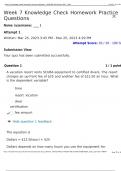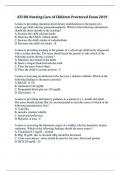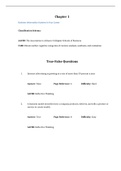Master Economic Psychology
December 2020
,This summary was written by 6 people, so the writing style may vary sometimes. Further, this
summary includes the following:
Introduction
Hofacker et al. (2016) Big Data and consumer behavior: imminent opportunities (9 pages)
The era of blind faith in big data . o’neil c. (2017)
Prediction 1
Gladstone et al. (2019) Can Psychological Traits be Inferred From Spending? Evidence from Transaction Data (10
pages)
Youyou et al. (2015) Computer-based personality judgments are more accurate than those made by humans (5
pages)
Prediction 2
Tucker (2014) Social Networks, Personalized Advertising, and Privacy Controls (17 pages)
Matz et al. (2017) Psychological targeting as an effective approach to digital mass persuasion (6 pages)
Consumer Reviews 1
De Langhe et al. (2016) Navigating by the Stars: Investigating the Actual and Perceived Validity of Online User
Ratings (17 pages)
podcast
Consumer Reviews 2
Dai et al. (2019) People Rely Less on Consumer Reviews for Experiential than Material Purchases (24 pages)
Kupor and Tormala (2018) When Moderation Fosters Persuasion: The Persuasive Power of Deviatory Reviews (21
pages)
Crowd Behavior 1
Muchnik et al. (2013) Social Influence Bias: A Randomized Experiment (6 pages)
Salganik et al. (2006) Experimental Study of Inequality and Unpredictability in an Artificial Cultural Market (4 pages)
Crowd Behavior 2
Brady et al. (2017) Emotion shapes the diffusion of moralized content in social networks (6 pages)
Kramer et al. (2014) Editorial Expression of Concern and Correction (5 pages)
Youtube video
Machine Behavior 1
Dietvorst et al. (2015) Algorithm Aversion: People Erroneously Avoid Algorithms after Seeing Them Err (15 pages)
Logg et al. (2019) Algorithm appreciation: People prefer algorithmic to human judgment (14 pages)
Machine Behavior 2
Awad et al. (2020) Drivers are blamed more than their automated cars when both make mistakes (45 pages)
Bigman and Gray (2018) People are averse to machine making moral decisions (14 pages)
Privacy
Brandimarte (2012) Misplaced Confidences: Privacy and the Control Paradox (8 pages)
Winegar Sunstein (2019) How Much is Data Privacy Worth? A Preliminary Investigation (16 pages)
1
,2
, Week 1 Introduction –
Hofacker, C. F., Malthouse, E. C., & Sultan, F. (2016). Big data and consumer
behavior: Imminent opportunities. Journal of Consumer Marketing.
Abstract: The purpose of this paper is to assess how the study of consumer behavior can
benefit from the presence of Big Data. This paper offers a conceptual overview of potential
opportunities and changes to the study of consumer behavior that Big Data will likely bring.
Big Data have the potential to further our understanding of each stage in the consumer
decision-making process. While the field has traditionally moved forward using a priori theory
followed by experimentation, it now seems that the nature of the feedback loop between
theory and results may shift under the weight of Big Data. A new data culture is now
represented in marketing practice. The new group advocates inductive data mining and
A/B testing rather than human intuition harnessed for deduction. The group brings with it
interest in numerous secondary data sources. However, Big Data may be limited by poor
quality, unrepresentativeness and volatility, among other problems. Managers who
need to understand consumer behavior will need a workforce with different skill sets than in
the past, such as Big Data consumer analytics.
Introduction
It has been said that the era of Big Data began at the point at which the costs of storing data
dropped below the costs of deleting it. Such data are increasingly available because more
interactions with customers are taking place in social media, online and on mobile devices
where all actions can be easily recorded.
Big Data are often characterized by three V’s:
- Volume: refers to the ‘bigness’ property
- Velocity: refers to the rate at which the digital processes make Big Data even bigger
- Variety: refers to new formats and types of data
In marketing, the main driver of the interest in Big Data is the potential usefulness of it for
informing marketing decisions and executing marketing campaigns.
Some have argued that Big Data consumer analytics has significantly transformed the way
marketing is conducted today. In a 2013 survey of senior markers in the USA, 85 cent per
USA agency and brand executives said Big Data had yielded more than half of marketing
initiatives when it came to increasing insights into consumer behavior.
Big Data and consumer decision-making
The authors discuss the Big Data phenomenon and its intersection with consumer behavior
(CB). They use a narrational device that moves along the steps of the consumer decision-
making process. The steps are problem recognition, search, alternative evaluation,
purchase behavior, consumption, post-purchase evaluation and post-purchase
engagement. According to Blackwell et al., the exchange relationship between the customer
and firm emerges from consumer problem-solving activities.
Problem recognition
In the first stage of consumer problem-solving, the consumer sees a gap between what he
or she has (or has experienced) and what he or she wants (or wants to experience).
Companies can sense when this moment is there from a variety of sources (e.g. search
queries, social media, addressable advertising) and direct marketing response.
Much discussion about products and issues with products takes place in social media
environments that can be monitored. This can be used to identify new products and
improvements. Moreover, companies are able to detect that product usage is slowing or
3
,stopped by using Ip addresses (IoT). The IoT refers to devices that are connected via the
internet. Therefore, it is possible that IoT artifacts might upload nonverbal reactions to
advertising.
The consumer may also provide early warning signs on social media that there are
problems with the relationship and companies have the opportunity to learn about the issues
from the above sources and address them.
Qualitative research methods such as in-depth interviews and focus groups have traditionally
been used to recognize problems. Such methods can be used to improve Big Data. For
example, an examination of what is being said on social media about a brand could help
prepare discussion outlines for face-to-face discussions with consumers.
Search
In the digital world, a problem is having too many alternatives. The enriched search process
now throws off digital data at every turn. In the past, a direct-to-consumer retailer would have
a record of all items that were purchased, but now a retailer can record all of the search
activities on its website (or app) that leads up to the purchase as well, such as log recording
all activities on the site including which items have been searched, clicked on, abandoned,
purchased, and so on. It also knows which search items attracted prospective consumers.
Blackwell et al. emphasized the difference between routine problem-solving, limited problem-
solving and extended problem-solving. Search effort is greatest for the latter category. It is
presumed that high-involvement choice will necessarily throw off more data than low-
involvement choice and will involve different types of data. The amount and type of data will
further vary depending on the product category and its mix of digital versus non-digital
attributes.
Alternative evaluation
The e-tailer will have data on alternative evaluations including consideration sets and
inferred choice rules based on navigation sequences. Shopping cart abandonment can
signal that customers are making price comparisons at other sites. Search behavior in
general can provide additional hints as to the way the consumer is planning to evaluate
alternatives.
Purchase behavior
Data sources include cameras in stores, mobile purchase activities on branded apps,
scanners at checkout, and so on.
Consumption
Media consumption is almost fully digital at this point of time. The offline part of our world is
shrinking. The quantified self and measured life are popular names for how we allow
more of our actions to be recorded. The IoT will accelerate this trend, creating digital data
from more types of consumption. For example, Strava records cycling/running workout
activity and uploads it automatically to Facebook and wearable technologies such as
watches and Fitbits record biometrics. The IoT will accelerate this trend, creating digital data
from more types of consumption including that generated by using cars, vacuum cleaners,
washing machines and so on. Devices may reveal highly intimate psychological details about
the wearer, possible including the three classic responses pleasure-arousal-dominance.
Consequently, managers will need to find ways of using these new data sources to
understand their customers, improve the execution of their marketing programs and make
their products stickier.
Post-purchase evaluation
4
, Customers evaluate the gap between their expectations and their consumption experience
during and after consumption. Positive or negative gaps may be described online in reviews,
tweets, photos, etc.
Post-purchase engagement
Product reviews are the prototypical Big Data exemplar. These exhibit all of the three V’s.
All of which have been shown to impact the reader. It is interesting to note that one review
writer can have an impact on later writers and that reviews are subject to intertemporal
effects. In addition to product reviews, the sources of post-purchase engagement are
particularly numerous and include mobile apps, check-in platforms, retweets, comments
made during public service exchanges and other forms of e-word-of-mouth and so on.
Exogenous factors
Detailed information can be integrated from weather sources, private list brokers, voting
records, highway sensors monitoring and numerous other sources. Varied Big Data can
provide a more holistic view of the consumers’ journey.
Problems associated with Big Data
Big Data can provide information complementary to traditional consumer behavior methods
while also providing an advantage to marketers. However, there are various negative
aspects as well.
Big Data come from the past
Big Data are ‘Big’ about the past. However, prescriptions for the future are more actionable.
Theories and models provide such prescriptions. Big Data can be used to generate insights
that inspire theoretical explanations, test theories and calibrate models, but have little value
without a theory and/or model to provide an explanation.
Big Data record what customers did, but not why
Motivation and attitude can only be inferred from many of the Big Data sources they
describe. One solution is to supplement Big Data sources with Little Data from more
traditional research methods (surveys). In the past, a large amount of consumer behavior
has relied on survey samples and experiments where consumers were asked about their
attitudes, intentions and behaviors. While attitudes could be measured, the
representativeness of such samples has often been questionable because of poor response
rates and sapling frames. However, Big Data offers the possibility of having records of
behavior for all current customers. The importance of understanding constructs such as
motivations, cognitions, emotions, etc., will not diminish, but the question is whether such
constructs can be inferred from behaviors. Another way to view the change is that in the
past, attitudes and other constructs at time t were used to explain behaviors at time t + 1. In
the world of Big Data, behaviors at time t affect attitudes and other constructs at t + 1.
Surveys will continue to be used, but the advantages of using records of customer behaviors
are intriguing and create opportunities to extend consumer behavior research.
Big Data quality cannot be assumed
Maintaining a clean database requires a substantial effort and the task of preparing a data
set for analysis will often take longer than the analysis itself. There can be conflicting data
and no way to know which version is more current.
Big Data sets may not be representative
Marketers should inquire about how the data were sampled and potential biases created by
the sampling procedure. For example, a company’s data may be detailed and numerous but
only about long-term customers. In this case, there is the problem of the survival bias. A
second example might occur if customers self-select into certain data fails or if managers
pick consumers to include on some systematic basis.
5











